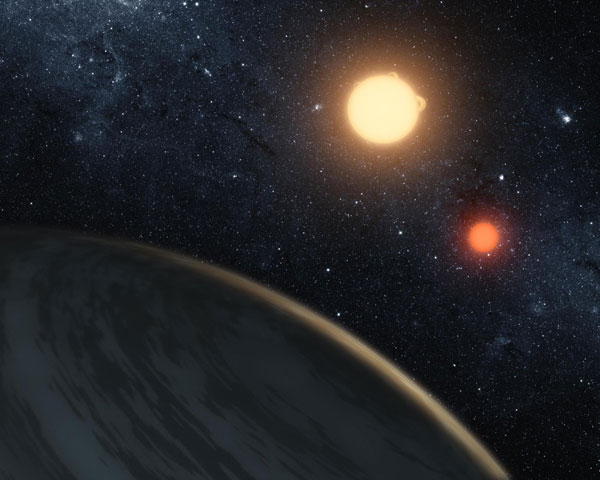Photos
1st planet orbiting 2 stars discovered
Updated: 2011-09-16 14:13
(Xinhua)
 |
|
NASA handout image shows an artist's concept of the circumbinary planet Kepler-16b - the first planet known to definitively orbit two stars. [Photo/Agencies] |
WASHINGTON - A team of researchers has discovered a planet that orbits around a pair of stars, the US space agency NASA announced Thursday.
This is the first instance of astronomers finding direct evidence of a so-called circumbinary planet. A few other planets have been suspected of orbiting around both members of a dual-star system, but the transits of the circumbinary planet have never been detected previously.
The team, led by Laurance Doyle of the SETI Institute in California, used photometric data from the NASA Kepler space telescope, which monitors the brightness of 155,000 stars.
They found the binary star system by detecting a system where the stars eclipsed each other from the perspective of the Kepler spacecraft. These stars have two eclipses: A primary eclipse when the larger star is partially blocked by the smaller star and a secondary eclipse where the smaller star is fully blocked by the larger star.
But the researchers also noticed other times when the brightness of the two stars dropped, even when they were not in an eclipse position. This pattern suggested that there was likely a third object involved. The fact that these so-called tertiary and quaternary eclipses recurred after varying intervals of time, and were of different depths, indicated that the stars were in different positions in their orbit at each instance. This result showed that the tertiary and quaternary eclipses were being caused by something circling both stars, and not an object circling one or the other star.
Measurements of the variations in the timing of all four types of eclipses, resulting from the mutual gravitational interactions of the two stars and the third body, demonstrated that the third object was, indeed, a planet. Their work indicates that the planet is less massive than Jupiter, possibly comparable in mass to Saturn, and that the larger of the two binary stars is smaller than our Sun.
Their findings will be published Friday in Science.
"This discovery confirms a new class of planetary systems that could harbor life," Kepler principal investigator William Borucki said in a statement. "Given that most stars in our galaxy are part of a binary system, this means the opportunities for life are much broader than if planets form only around single stars. This milestone discovery confirms a theory that scientists have had for decades but could not prove until now."
E-paper

The snuff of dreams
Chinese collectors have discovered the value of beautiful bottles
Perils in relying on building boom
Fast forward to digital age
Bonds that tie China. UK
Specials

Let them eat cake
Cambridge University graduate develops thriving business selling cupcakes

A case is laid to rest
In 1937, a young woman'S body was found in beijing. paul french went searching for her killer

Banking on change
Leading economist says china must transform its growth model soon
